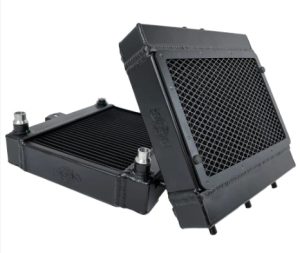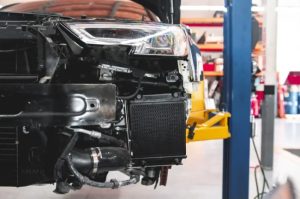High-output and turbocharged engines generate considerably more heat than standard setups. Every additional bar of boost, every race-lap, every heavy load places enormous thermal demand on the cooling system. That’s where auxiliary radiators come into play — supporting the main radiator system and aiding in maintaining safe, reliable operating temperatures.
Why Auxiliary Radiators Matter

When an engine is tweaked for more power — whether by turbocharging, supercharging, aggressive tuning, or repeated high-load use — the standard cooling system may hit its limits. Key issues include:
-
Rapid heat soak of coolant and core materials
-
Elevated engine and intake temperatures, leading to detonation, reduced output or limp-mode
-
Overworked main radiator and increased thermal stress on hoses, pump, head gasket
-
Localised hotspots (e.g., around turbo, oil cooler, or charge air cooler) that strain components
An auxiliary radiator (also known as a secondary cooler or supplementary heat exchanger) is designed to assist by increasing total cooling capacity, enhancing heat dissipation, reducing thermal load, and helping the system keep its cool even under duress.
What Is an Auxiliary Radiator?
At its core, an auxiliary radiator is a secondary heat exchanger that works alongside the main radiator. It may be placed in series or parallel flow, often positioned where airflow is available (such as behind a bumper or near a wheel-arch) and where heat load is high. Key functions include:
-
Increasing surface area for coolant to transfer heat to ambient air.
-
Reducing coolant return temperature to the engine or other systems, thereby improving the efficiency of the cooling cycle.
-
Handling specific components’ heat load — e.g., transmission oil coolers, charge-air coolers, turbo lubrication oil etc.
Key Benefits & When They Are Worthwhile
Here’s a list of major benefits, followed by scenarios when adding an auxiliary radiator is highly recommended.
Benefits:
-
More stable temps under load → better power delivery
-
Reduced risk of heat soak into engine, turbo, intercooler
-
Less thermal stress on components → longer life
-
Improved performance consistency, especially on track or in heavy ambient temperatures
-
Possibility to upgrade beyond OEM limitations
When it’s worth it:
-
Vehicle is turbocharged/supercharged and producing significantly more heat than stock
-
The car is used for racing, track days, hill climbs, heavy towing or hot-climate use
-
The OEM cooling system is reaching its limits (frequent overheat warnings, limp mode, elevated coolant temps)
-
After major engine mods (higher boost, bigger turbo, additional oil cooling)
Technical Considerations: What to Look For
| Parameter | Why It Matters | Typical Upgrade Specs* |
|---|---|---|
| Core size (rows, thickness) | Bigger core = more coolant capacity, more air contact | Many aftermarket units upgrade from 1-row to 2-row, or enlarge depth from ~30 mm to ~40-50 mm. |
| Fin density / fin height | More fins increase surface area but can restrict airflow if over-dense | E.g., 5 mm tall fins and multi-louver designs in high-performance units. |
| Material / construction | Aluminum (all-aluminium) and TIG-welded tanks resist fatigue and provide better conductivity | Many “racegrade” auxiliary radiators specify 100% aluminium, TIG-welded. |
| Placement & airflow | Cooler must see airflow and be integrated with ducting | Some installs require trimming of ducts or repositioning to optimise cooling. |
* Typical values vary heavily by vehicle/application; always refer to the manufacturer’s data.
How They Integrate into the Cooling System
Auxiliary radiators can be integrated in a few ways:
-
Series cooling: Coolant flows from main radiator → auxiliary radiator → back to engine or loop. This lowers return temperature.
-
Parallel cooling: Coolant splits, some through main radiator, some through auxiliary, then recombines. This can reduce pressure loss or restrict less.
-
Dedicated loop: Sometimes an auxiliary radiator serves a separate subsystem — e.g., transmission oil, charge-air loop, or turbo oil cooler. In that case, it is not directly in the engine coolant main loop.
Integration also involves appropriate hose routing, ensuring good airflow, possibly trimming or adding ducting, and ensuring that the cooling system’s thermostat, fan, and control logic remain suitable.
Table: Signs You Might Need an Auxiliary Radiator
| Symptom | Underlying Cause | Auxiliary Radiator Role |
|---|---|---|
| Coolant temps staying high on track/under load | Main radiator capacity exceeded | Auxiliary increases cooling capacity |
| Heater blowing cool air (engine too hot but heater ineffective) | Air in cooling loop, overheating core | Auxiliary helps reduce temps and stabilise flow |
| Engine going into limp mode or boost reduced after sustained driving | ECU protecting engine from overheating | Auxiliary reduces heat soak and thermal stress |
| Repeated head-gasket issues or coolant boil-over | Overheating, hotspots, excessive thermal cycling | Auxiliary reduces thermal peaks and cycle count |
Installation & Best Practices

-
Ensure correct fitment: many aftermarket auxiliary radiators are designed as drop-in for specific models.
-
Confirm clearance behind bumper, correct ducting and airflow path.
-
Upgrade coolant hoses and clamps if necessary, to match higher flow and capacity.
-
After installation, bleed the cooling system properly (remove air) to ensure full benefit.
-
Monitor coolant temperature and system pressures, especially during first use under load.
-
Maintain clean fins and remove road debris/rock guards — dirty or damaged fins reduce efficiency. Many units include protective guards.
Summary Table of Advantages vs Considerations
| Pros | Cons |
|---|---|
| Improved temperature control and engine protection | Additional cost and installation time |
| Better performance consistency (especially under heavy load) | Requires correct placement and airflow — poor install can reduce benefit |
| Longer component life (engine, turbo, hoses) | Adds complexity to cooling loop (more hoses, connectors) |
| Prevents overheating and allows higher output tuning | If other cooling system parts are weak, auxiliary alone may not solve all issues |
Final Thoughts
If you’re running a high-output engine, frequent track sessions, heavy towing, or operating in hotter climates, installing a quality auxiliary radiator is a wise investment. It complements your main cooling system, helping to manage the thermal load that high-power setups generate. When selecting a unit, focus on core size, material, fin design, fitment and ducting.
Upgrading your cooling system makes sense not just for performance, but also for reliability and longevity. To explore high-quality options for your application, check out this link: Buy Radiator & Components online.
Optimising your cooling system isn’t just about keeping things cool — it’s about unlocking consistent performance, saving components from stress, and allowing your engine to deliver its full potential.